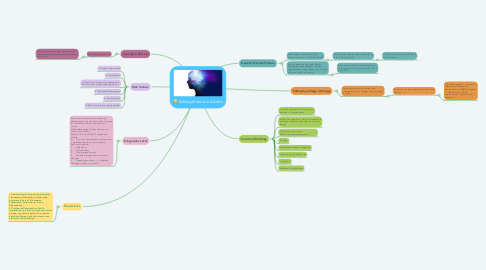Schizophrenia in Adults
Damaris Pinto-Florezにより


1. Causative Factors
1.1. Exact cause is unknown
1.1.1. Likely combination of genetics, chemical interactions in the brain, external situations and events.
2. Diagnostic tests
2.1. Rule out other causes by using: Drug detection via urine and blood test. Imaging (CT and MRI to detect possible brain tumor) Observable patient actions that can be found in the DSM -5 Example of one of DSM -5 diagnostic criteria: A. 2 or more characteristic symptoms for a significant portion of time during a one-month period: 1. Delusions 2. Hallucinations 3. Disorganized speech 4. Grossly disorganized or catatonic behavior 5. Negative symptoms, i.e., affective flattening, alogia, or avolition
3. Risk factors
3.1. 1. Living in urban area
3.2. 2. Immigration
3.3. 3. Later winter spring birth (exposures to FLU virus during neural development)
3.4. 4. Advanced Paternal age
3.5. 5. Family history
3.6. 6. Many more factors being studied
4. Treatments
4.1. 1.Pharmacologic: (Long acting injectables: Fluphenazine, Haloperidol, Aripiprazole, Aripiprazole lauroxil, Olanzapine, Paliperidone, Paliperidone 12-wee, Risperidone) 2.Psychosocial interventions: Family interventions (problem solving), social skills training, cognitive remediation, cognitive behavioral therapy, self help groups, and electroconvulsive therapy.
5. Pathophysiology etiology
5.1. Neurodevelopmental disorder with neuropathological changes that may begin in utero
5.1.1. Reductions of gray matter in multiple brain regions
5.1.1.1. Neurotransmitters: 1. Dopamine imbalances 2.Glutamate: hypofunction of NMDA receptor 3. Dysfunction in GABA interneurons 4. Acetylcholine receptors
6. Genetic Details/Factors
6.1. Monozygotic twin studies show concordance rate of 40 to 50 percent
6.1.1. Dizygotic twin studies show concordance rate of 10-15 percent
6.1.1.1. 100 loci are associated with risk of schizophrenia
6.2. Specific genes not yet identified for etiology however polygenic models suggest that multiple genes have additive effects that lead to disease.
6.2.1. Study shows people with schizophrenia have long arm of chromosome 22 (Up to date,2020)
